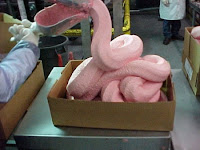It started with the "pink slime" uproar. There's this "food product" that is basically taking the less palatable parts of the animal we've already butchered for the good parts, and process them with ammonium hydroxide to make it edible. Essentially, the "meat" used is connective tissue like ligaments and cartilage and such.
Apparently this is all of the sudden unacceptable, even though it's basically hot dog meat, or some other kind of processed sausage. I guess that once it's made into a nugget or burger patty, that's somehow deceptive and evil.
Then there's the ubiquitous 'bugs in my food' freakout every time some freshman journalist discovers that there are government standards for how much bug we allow in our processed food. A story as old as me. Or older, since I probably "re-discovered" these truths in the same way people are now.
Today I read an article from CBS News about how awful it is that Starbucks has crushed beetles in it. The same beetles that people were in a uproar over in the 90s when they found out that Snapple Watermelon has crushed cochineal beetles in it.
 | |
| Credit: Frank Vincentz |
These bugs have been used for color since before this country was founded. The color was first recorded used by Mayans in the 15th century. Our first stamps used ink made with these bugs. Carmine rose, carmine and carmine lake, all from the carminic acid found in the beetle.
In fact, this is one of the tools forensic art historians use to determine if a painting is authentic or not. There aren't many paints still made with this color, as the process to get the color is slow and expensive. Alizarin Crimson came along and supplanted it. Forgeries often fail to take this into account and use modern pigments.
Wikipedia: "Cochineal is one of the few water-soluble colorants that resist degradation with time. It is one of the most light- and heat-stable and oxidation-resistant of all the natural organic colorants and is even more stable than many synthetic food colours. The water-soluble form is used in alcoholic drinks with calcium carmine; the insoluble form is used in a wide variety of products. Together with ammonium carmine, they can be found in meat, sausages, processed poultry products (meat products cannot be coloured in the United States unless they are labeled as such), surimi, marinades, alcoholic drinks, bakery products and toppings, cookies, desserts, icings, pie fillings, jams, preserves, gelatin desserts, juice beverages, varieties of cheddar cheese and other dairy products, sauces, and sweets."


No comments:
Post a Comment